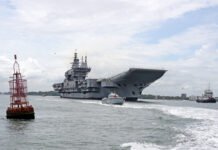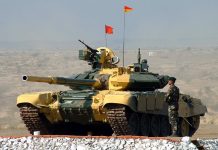Urban military operations, which range from besieged cities and towns, hostage situations, street patrols and gunfights, guerrilla attacks, and gang warfare, appear to represent new-age warfare, and are here to stay.
No conventional battlefield can possibly prepare you for the nightmare that is a city besieged. Urban combat is the most difficult for a variety of reasons. For starters, it takes the longest amount of time because every building, every room, every subway tunnel, every car, every sewer pipe, every nook, and cranny of this massive maze must be searched,” according to Max Brooks in his book “The Zombie Survival Guide”.
Modern day warfare in the urban theatre involves risks ranging from collateral damage of civilian casualties to paralysing everyday life, and to destruction of government structures. Urban warfare has come a long way from the American-Mexican Battle of Monterrey in the mid-19th century right up to present-day Taliban insurgents in Afghanistan which fought the Afghan Government forces in densely populated towns and cities, bombing hospitals and schools, and taking over provincial capitals. The Taliban achieved a world record according to United Nations figures for civilian casualties.
Contemporary Operations
Recent examples of limited urban conflict can be seen in the Israeli-Hamas conflict in Gaza where high-rise buildings were brought down, craters made on busy main roads by Israeli attacks, while close to 4,000 rockets were launched by Hamas on Israeli cities, resulting in the deaths of hundreds on both sides. India experienced its first major urban combat operation during the 2008 Mumbai terror attacks, better known as the ‘26/11’ attacks, where close to 200 innocent people were killed amidst coordinated shooting and bombing assaults in a four-day operation at the Taj Palace hotel.
Referred to differently by militaries worldwide, such as Operations in Built-Up Areas (OBUA), Fighting in Built-Up Areas (FIBUA), Fighting in Someone’s House (FISH), Causing Havoc in People’s Streets (CHIPS), Military Operations on Urban Terrain (MOUT), Operations in a Volatile Uncertain Complex Ambiguous (VUCA) environment, urban combat poses numerous challenges including:
- demographic implications
- collateral damage
- destruction of public property
- hostage situations
- attackers using populated areas to hide.
Equally challenging is the gaming or training in limited and controlled environments for these operations. The complexity of urban warfare lies in an undefined battle theatre compared to a conventional one, with the need to gauge the actual enemy, and launch assaults with the protection of civilians in mind. Other challenges include:
- restricted fields of view and fire
- limited battlefield mobility
- near zero manoeuvrability of Armoured Fighting Vehicles and Infantry Combat Vehicles
- the need to clear, secure and hold areas
Gaming in Urban Terrain
Former Indian Army Director General of Military Operations (DGMO) Lt. General (retd.) Vinod Bhatia says, “MOUT requires a different doctrine, flexibility in organisation, special military hardware, training and leadership. The simulation models for MOUT have been developed at the tactical level and are effective in training the leaders. The models are generic in nature as the modus operandi will change depending on the terrain and task. Fortunately, the Indian Army’s experience in counter terrorism (CT) ops comes in handy in urban areas.”
Besides actual training exercises, military war gaming largely employs tools like:
- 3D and 2D models
- micro models
- sub models
- computer programmes with standard simulations
- technical inputs pertaining to geography and chronology
Achievement-aligned performance has given rise to research-based gaming which measures efficacy under a certain environment. Gaming which ranges from space to guerrilla warfare is still followed on the patterns of WWII offensives. The urban terrain is far from the regular topography owing to its compound and multifaceted nature, in terms of roads, infrastructure, routes and streets, residences and the overall plan of a city enmeshed with urban architecture which makes warfighting a particularly difficult exercise.
Urban areas present an extraordinary fusion of exterior, interior, horizontal, vertical, and subterranean forms superimposed on natural vegetation and drainage. The surrounding countryside may even appear as superimposed on an urban area on a map. The purview and actual size of urban military operations are many times that of a similarly-sized undeveloped piece of agricultural land. For example, a high-rise building occupies the same land area as a small agricultural field, but each floor on the building incorporates approximately an equal area as the ground floor. Therefore, a 10-storey building, with its multiple floors and roof effectively has more area to defend compared to a ground area of the same size. It is this density and complex geography what makes urban military warfare more demanding in terms of resources, manpower and time management.
Different Dimension
Cities and towns often get transformed after experiencing volatile operations, in the areas of power, electricity, sewage and drainage, with essential services shutting down. The sheer volume and density created by this urban geometry makes urban operations so resource intensive in terms of time, manpower and material. Sometimes, huge piles of rubble can accumulate thereby incapacitating transportation, coupled with the destruction of urban structures which also alter geography through the demolition of reference points.
Intelligence, Surveillance and Reconnaissance capabilities need specialised equipment such as:
- corner shot weapons
- artillery in direct fire role
- Directed Energy Weapons
- helicopter gunships
- drones for surveillance and targeting
A virtual environment (VE) MOUT simulated training module includes creating a virtual urban habitat, with near perfect specifications of interiors and exteriors of the concrete structures, conveniently allowing entry and movement within them. Though VE can be used effectively for MOUT training, some tasks are not meant for VE, for instance climbing a virtual rope. Numerous militaries worldwide are using workarounds by successfully amalgamating virtual and real scenarios, like using representations of actual rifles of the same weight and specifications, and pulleys used for counter-balancing rope climbing. More intimidating tasks include movement over windowsills, wire meshes, climbing walls and spatial walks. It has been discovered that creating a workaround integrated system of ledges, windowsills, and walls in modelling MOUT situations may prove to be less cost-effective compared to real structures.
A research study sponsored by America’s Marine Corps Systems Command in the late 1990s listed the following MOUT tasks suited for VE training, for movement in urban areas outside buildings:
- Fundamental motor skills
- Avoiding open areas
- Conducting movement under cover
- Selecting routes that reduce or negate possibilities of friendly fire
- Crossing open areas such as streets, fields, open areas between buildings, rapidly under cover of fire
- Moving on rooftops not covered by direct enemy fire
- Moving in and along streets
- Limitations
Urban operations can best be described as an irregular threat which makes it difficult to distinguish friend from foe, and frequently involve landing troops in the realm of endangering one’s own soldiers or inflicting civilian casualties. Dealing with civilian populations who might be inimical to the military, the success of missions depends on having the locals on one’s side, which means that connecting with them culturally is mandatory.
Key Considerations
3D models create limitations of situational awareness. Urban structures differ both in construction materials and design which might affect the functionality of weapons, thereby making troops vulnerable. For example, it is important to be able to calculate the outcome whether a stone wall would have the same effect as a wooden fence. In the same way a realistic simulation of the volume of debris caused by demolitions or collapse of weak structures with helicopter landings, is equally important.
A Dutch research study for NATO concluded that 3D models do not present an accurate picture for tactical training, options for cover, durability of structures, and ammunition type to be used. Feature reality of ammunition, weapons and vehicles are limited and require thinking and decision-making in 3D.
Simulation Advances
Artificial Intelligence used in simulated war games of simulated soldiers is generally different and considered unsuitable for urban environments, as inadequacies can be witnessed in human reactions such as collision prevention, audio-visual means of detection of enemy fire, shooting, fleeing etc., as can be seen in a real scenario. Live training sessions have the advantage of eliciting real time responses in the way soldiers run, walk, kneel, handle weapons, and offer the opportunity of being able to observe their hand and eye movements.
In one of its research studies, American think tank, the Rand Corporation, found that, “Traditionally limited to war, gaming is now applied to business, urban, social, and other areas. Since all deal with confrontation between protagonists, “confrontation analysis” may be the appropriate term, with military gaming a branch concerned with military problems.”
As world powers transition from the post-Cold War era and enter new theatres of warfare involving combat in a terrain altered by human activity like urbanisation, exemplified by the building of villages, towns and cities, it is imperative that there is better planning and training in order to execute this role.












